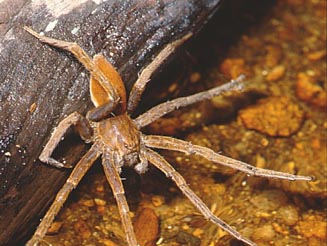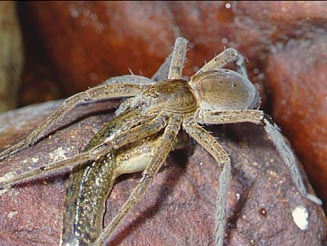|
Genus: Thalassius (fishing spiders)
Life
> Eukaryotes
>
Opisthokonta >
Metazoa
(animals) > Bilateria > Ecdysozoa > Panarthropoda > Tritocerebra >
Arthropoda > Arachnomorpha > Cheliceriformes > Chelicerata > Euchelicerata
> Arachnida > Araneae
> Araneomorpha > Family: Pisauridae
The Fishing spiders belong to the genus Thalssius, a group of large to
very large spiders (15 to 30 mm). The more plainly marked spiders very
superficially resemble the rain spiders, Palystes but
the latter has banding under the legs and a white clypeal stripe.
Thalassius is very variable in colour ranging from olive brown without
markings or reddish to dark brown with the typical cream lateral bands or cream
speckling and no banding with various colour forms occurring in the same species
in the same locality.
Thalassius is always associated with water and
appears to be both diurnal and nocturnal often retreating amongst vegetation by
day. It can be seen resting on the water surface waiting for prey with its hind
legs anchored on a leaf or rock or with its entire body on the water anchored to
the shore with only a silk thread. The surface tension of the water prevents the
spider from sinking. When it detects vibrations of passing prey such as fish,
tadpoles, frogs and other invertebrates, it dives into the water and after much splashing the spider emerges from its wrestling match with its prey held
under its body. It then retreats to a quiet spot in the vegetation or on a rock
to consume its prey. These spiders can be voracious feeders as one was seen to
consume two Rana tadpoles, both larger than the spider, within 24 hours.
Thalassius' integument (body covering) has a waxy coating that allows
it to remain dry.
|

|

|
|
Thalassius sp. [image N. Larsen ©] |
Thalassius spinossissimus
with a tadpole. [image N. Larsen ©] |
|

|
|
|
Thalassius spinossissimus
with a tadpole. [image N. Larsen ©] |
|
Text by Norman Larsen ©
|
